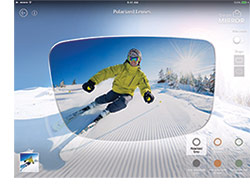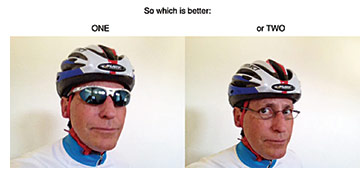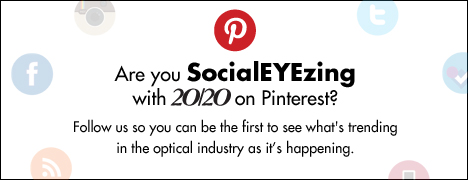|
Your monthly guide to staff training outside the box
Eyes / Lenses / Fitting Lenses / Free-Form / Frames / Sunwear / Patient Solutions / In-office / Standards
Sunwear
DOUBLE THE OPPORTUNITY WITH SUNWEAR
Here’s what to do to double the opportunity with sunwear. Right from the start—develop and reinforce the idea of an eyewear fashion wardrobe. For work and play, “Do you wear the same outfit to a business meeting and a night out?” You have different looks, on different days, “What about for sunwear for driving during the day, clear lenses at night?” Let me tell you about reading glasses.
Offer the best options appropriate to the patient’s needs and lifestyle and convert it to wants. For contact lens wearers, everyone needs sunglasses. For safety or sport eyewear, protect your eyes during water and in-motion sports.
See Plus »
|
TALK TO EVERY MOM ABOUT SUNGLASSES AND KIDS
Unfortunately, not enough kids get the sunglasses that they should. However, there’s good news in that when sunglasses are considered, most ECPs sell photochromics to protect a child’s eyes indoors and out. A Jobson survey found that of the kids who wear Rx sunglasses, 72 percent wore photochromic lenses.
Having photochromic lenses meets mom’s concerns about sun, cost, as well as potential loss. Photochromic lenses are so convenient for kids when carrying another pair of Rx sunglasses is impractical because of age. And photochromics are available in super impact resistant polycarbonate or Trivex material.
In fact, adding lens technology improvements like no-glare and photochromic lenses add to profitability. Depending on your lab, any MVC benefit and pricing, you can increase the average sell price an extra $75 to $100 per sale. Who benefits? The child benefits from the extra clarity of anti-reflective lenses and photochromic protection while wearing a lens that’s fun when it changes tint outdoors. This encourages kids to wear them. Be sure that your schools understand photochromics (visit to review glare, UV and safety hazards that eyewear can help), especially if they don’t allow sunglasses on school grounds.
See Plus »
|
|


|
SUNGLASSES FOR KIDS
Sunglasses perform two important functions besides looking terrific. For kids, they are preventative and protective.
Did you know that 75 percent of UV radiation is transmitted through the lenses of children under 10? That’s because the crystalline lenses inside a child’s eye does not yet have the natural chemical blockers that will absorb UV radiation. At birth, the lens is 100 percent transparent; for those under 10, about 75 percent is transmitted and by age 25, only 10 percent of the UV gets through. That’s why children receive three times an adult’s exposure to UV annually. And they spend more time outdoors so they are more at risk. Accumulated UV damages the lens and the retina.
There are thousands of eye injuries each year to kids. It’s believed that most of those eye injuries could be prevented with a pair of protective sunglasses. It’s critical since children rely on their eyes, after all, 80 percent of what is learned is visual. Unfortunately, parents are often the problem. Parents don’t think kids have eye problems, or have eyes more susceptible to damage so teach mom. Mom is the health care decider in the family.
See Plus »
|
USE A TABLET DEMO

Take the doctor’s product prescription and recommendation; for example, polarized sunglasses because of sensitivity to sunlight and glare… and turn it into a well-practiced demonstration. A scripted demo changes a prescription into a real product because you’re demonstrating patient benefits. Once a benefit is well understood, that creates value and ensures that you can get commitment.
See Plus »
|
A DOCTOR’S RECOMMENDATION
Many patients are just getting used to the idea of wearing sunglasses regularly, so you and your staff may be hesitant to start encouraging these same patients to invest in a pair of prescription sunglasses. However, putting patients in high-quality prescription sun lenses is a great way to protect patients’ eyes and improve their enjoyment of the outdoors. It is a way to leverage lifestyle dispensing, as you better understand your patients’ work, play and the vision needs that accompany those activities. Prescribing prescription sunwear is also a winner for the OD and their practice, as prescription sunglasses are much more profitable to sell than plano sunwear.
See Plus »
|
HOW MANY SUNGLASSES?

We have a very solid sunglass collection. We carry four of the top brands in sunwear (Oakley, Ray-Ban, Maui Jim and Costa). They represent 20 percent of our entire inventory. We also have good turn with our fashion sunwear. I feel our sunglass collection is as strong as any place. We just need patients to know the importance of protective sunwear and polarized lenses. This could be emphasized as much as the Rx.
See Plus »
|
CYCLING GLASSES, $1,500

My cycling glasses, with four sets of lenses cost around $1,500. Sounds a little scary, doesn’t it? Most people only ride their bikes on clear sunny days, so they should invest in one set of lenses, probably sunglasses, in a suitable wrap frame. I suggest polarized lenses for the most comfort and the best vision. In single vision, a good pair could be purchased for about the same cost as a set of cycling shoes and pedals. Good vision will keep you from running over broken glass or nails and could save you the unpleasant chore of changing a flat tire on the roadside. No guarantees, but you can dodge road debris much easier if you can see it. Precision vision provides you with an extra margin of safety in traffic too. And if you like to speed down mountainsides on narrow twisting roads on single dirt tracks, you want to be seeing your best. Or maybe you’re a newcomer to cycling; make sure your eyes are protected and you can see what’s down the trail.
See Plus »
|
CONTACT LENS WEARERS NEED SUNGLASSES
Many contact lens wearers are surprised to know that their newfound freedom comes with other requirements: care and maintenance of lenses, a heightened observation of ocular hygiene and extra vigilance about the state of their eyes. Many new contact lens wearers had never thought about these before first obtaining contact lenses. During a patient’s initial contact lens fitting, when the patient is being educated on the care and maintenance of contact lenses, it’s important to mention the need for sunglasses. New contact lens wearers may be under the impression that contact lenses block UV light and will substitute for sunglasses; and while there are lenses which do provide some UV protection, it’s important that your patients know contacts alone are insufficient to both block UV light from the skin and eyelids, as well as relax the eye and provide the sharpest, clearest level of vision possible. To put it simply, contacts correct; they don’t completely protect—not against UV, bright light or glare—all concerns that a pair of sunglasses will take care of simply and efficiently.
See Plus »
|
|


|
|